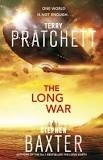The Long War (The Long Earth Cycle book 2) by Terry Pratchett & Stephen Baxter (book review).
In ‘The Long War’ by Terry Pratchett and Stephen Baxter, the second book of ‘The Long Earth Cycle’, humanity has colonised the Long Earth for some time. The Long Earth being a multitude of alternate Earths devoid of human life. Ours is called Datum Earth to distinguish it from the alternate ones.
It all began on step day, the day when the plans for a simple device called a stepper were published and many people stepped for the first time into the Long Earth. It is now twenty-five years after step day and ten years after the journey of Joshua Valienté and, unbeknownst to the public, Lobsang, chronicled in the first book, ‘The Long Earth’. Mankind has colonised the Long Earth for nearly a generation and new forms of communities have developed, which span more than one Earth. It is also ten years after the explosion of a nuclear bomb in Datum Madison, the far-reaching event which concluded book one. Most of the town’s inhabitants managed to step away in time, but this event changed the face of the Long Earth. Many more people stepped away from Datum Earth and the ones who didn’t want to or couldn’t step developed a deep paranoia concerning the steppers.
The protagonists of the first novel, Joshua Valienté, Lobsang, Sally Linsay and retired Police Lieutenant Monica Jansson have all gone their separate ways. Joshua is now married with a son and mayor of a little town called Hell-Knows-Where out in the Long Earth. Lobsang, the AI that insists upon being the reincarnation of a Tibetan motorcycle repairman, has scattered multiple versions of himself all over the Long Earth to learn more about it. Sally wanders through the Long Earth as she has always done, following her own agenda, whereas Jansson enjoys her retirement.
But all is not well in the Long Earth. On the one hand, more and more news travel from Earth Earth reporting about the maltreatment and even killing of trolls. You remember the trolls, the naturally stepping, peaceful humanoids who inhabited the Long Earth since long before humanity stepped for the first time. On the other hand, the government of the Datum United States tries to exert more control over its footprint on the Long Earth. The city of Valhalla in the High Meggers, a term referring to parallel earths tens of thousands of steps away from Datum Earth, declares its independence from Datum Earth and many colonies join in. The Datum US Government reacts by sending out a fleet of US military twains, airships able to step, named after and based on the airship which Joshua and Lobsang used for their journey in book 1. War across the Long Earth seems imminent. But is war still an option if there is a vast amount of places to escape to? Can one government really control all of the Long Earth? How can you be threatened if you can just step away to the next world? But this is only the plotline whose central character, Maggie Kauffman, captain of the twain Benjamin Franklin, is new to the reader albeit decisive for the course and outcome of the titular Long War.
Sally Linsay pops up in Hell-Knows-Where and involves Joshua in a search for the trolls who have begun to vanish from the Long Earth. Sally later recruits Jansson as well, just after her and Joshua’s paths split up. Besides this main plot, there is also the exploration journey of Roberta Golding, one of the kids from Happy Landings, who steps eastward on a Chinese airship expedition and the journey of Nelson Azikiwe, who stumbles upon a mystery and by trying to solve it finds an even bigger mystery which gives his life a new direction.
As in book 1, journeys are at the heart of all the plotlines in this novel. The plots concerning Joshua Valienté, Sally Linsay, Monica Jansson and Maggie Kauffman all have to do with the Long War and form the bulk of the novel. The other two plots seem, as of now, unconnected to the rest but I’m quite sure that they will become relevant in the next books.
‘The Long War’ expands upon the themes and ideas of the first book and explores new ones. Are there more directions in which to step, apart from east and west? Will First Person Singular become a threat to humanity or is it the future of mankind? Are there any advanced races out there in the expanse of the Long Earth? Still living ones, that is. How will the concepts of ‘country’ and ‘nationality’ change? How do we deal with other sapient creatures not looking human, in that context slavery and colonisation come to mind? How are politics on Datum Earth changed through crowds of people stepping away from there? There are many more questions which are raised and I’m convinced will be answered in subsequent volumes.
The novel is a quite natural extension of the first book and broadens our view on the Long Earth a bit, adds new plotlines, new characters and more sapient races to the mixture we know from book 1. All in all it feels a lot like it prepares the ground for the next novels to give them a head start. If you want to read stories with well-developed and developing characters or if you want to read military SF, go elsewhere. But if you want to read a good yarn containing the aforementioned themes and lots of ideas you can’t go wrong with this book. ‘The Long Mars’, the third book in the series, will be published soon. I am very excited already and looking forward to it.
Sven Scheurer
March 2014
(pub: Doubleday/Transworld. 421 page hardback. Price: £18.99 (UK). ISBN: 978-0-857-52011-1)
check out websites: http://www.doubleday.com/, www.terrypratchett.co.uk and www.stephen-baxter.com





